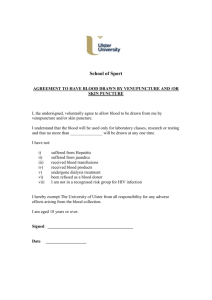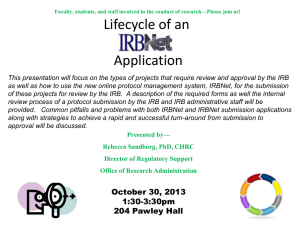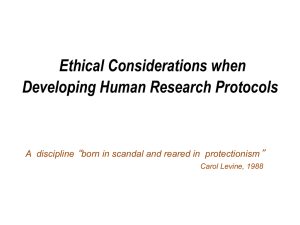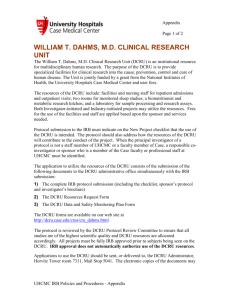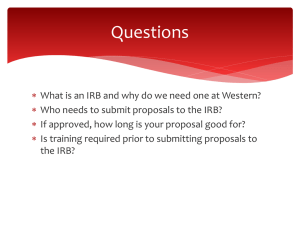12-3 Research Studies Involving the Collection of Blood Samples
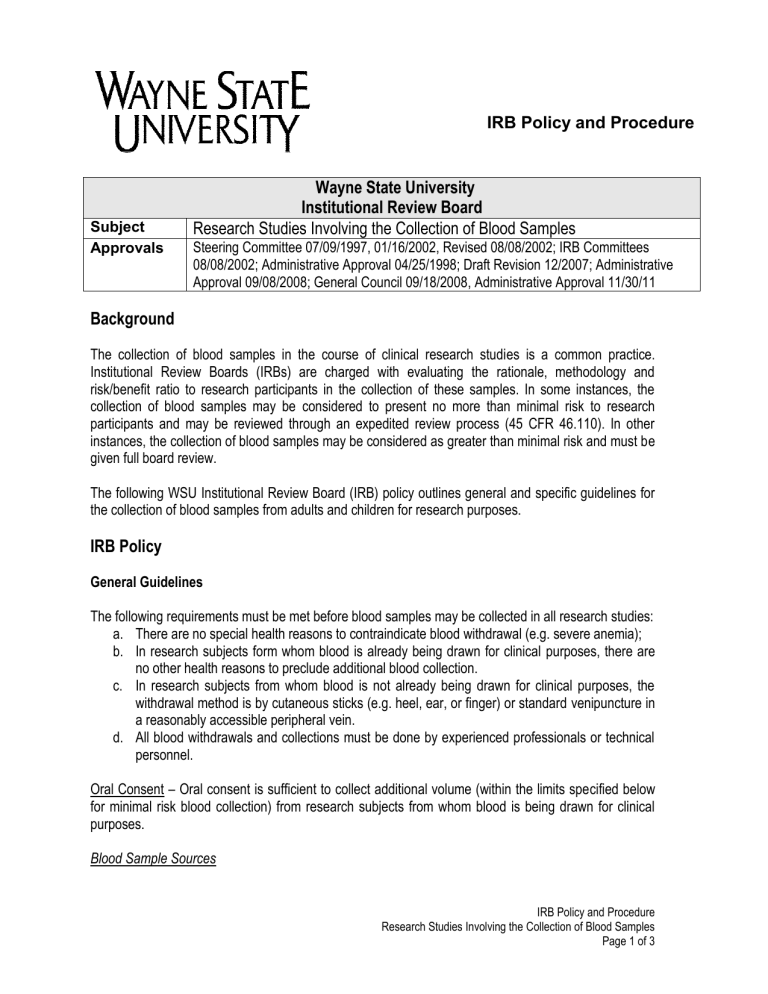
IRB Policy and Procedure
OFFICE PROCESS
Wayne State University
Institutional Review Board
Subject
Research Studies Involving the Collection of Blood Samples
Approvals
Steering Committee 07/09/1997, 01/16/2002, Revised 08/08/2002; IRB Committees
08/08/2002; Administrative Approval 04/25/1998; Draft Revision 12/2007; Administrative
Approval 09/08/2008; General Council 09/18/2008, Administrative Approval 11/30/11
Background
The collection of blood samples in the course of clinical research studies is a common practice.
Institutional Review Boards (IRBs) are charged with evaluating the rationale, methodology and risk/benefit ratio to research participants in the collection of these samples. In some instances, the collection of blood samples may be considered to present no more than minimal risk to research participants and may be reviewed through an expedited review process (45 CFR 46.110). In other instances, the collection of blood samples may be considered as greater than minimal risk and must be given full board review.
The following WSU Institutional Review Board (IRB) policy outlines general and specific guidelines for the collection of blood samples from adults and children for research purposes.
IRB Policy
General Guidelines
The following requirements must be met before blood samples may be collected in all research studies: a.
There are no special health reasons to contraindicate blood withdrawal (e.g. severe anemia); b.
In research subjects form whom blood is already being drawn for clinical purposes, there are no other health reasons to preclude additional blood collection. c.
In research subjects from whom blood is not already being drawn for clinical purposes, the withdrawal method is by cutaneous sticks (e.g. heel, ear, or finger) or standard venipuncture in a reasonably accessible peripheral vein. d.
All blood withdrawals and collections must be done by experienced professionals or technical personnel.
Oral Consent – Oral consent is sufficient to collect additional volume (within the limits specified below for minimal risk blood collection) from research subjects from whom blood is being drawn for clinical purposes.
Blood Sample Sources
IRB Policy and Procedure
Research Studies Involving the Collection of Blood Samples
Page 1 of 3
a.
Cord Blood – Blood from the umbilical cord (cord blood) can be used, following IRB review and approval, when blood is extracted from the placental side of the cord after it has been clamped and severed. b.
Stored Blood – Sera, plasma, and other blood components that have been previously collected for clinical or research purposes are considered stored specimens. The use of stored specimens may be exempted, expedited or require full board review depending on the nature of the proposed investigation (see WSU Policy/Procedure: “Use of Biological Specimens for
Research”).
Blood Sample Collection from Adults
Michigan state law defines adults as individuals 18 years of age or older.
Minimal Risk Blood Collection
When the collection of blood samples presents minimal risk to adult subjects they may be one by finger stick, heel stick, ear stick, or venipuncture under the following conditions and guidelines: a.
Blood samples may be collected for research purposes from healthy, nonpregnant adults who weigh at least 110 pounds. The amounts drawn may not exceed 550 ml in an 8 week period and collection may not occur more frequently than 2 times per week; or b.
Blood samples may be collected for research purposes from other adults (not designated in a. above), after considering the following; age, weight, and health of the subjects, the collection procedures, the amount of blood to be collected, and the frequency of collection. For these subjects, the amount drawn may not exceed the lesser of 50 ml or 3 ml per kg in an 8 week period and collection may not occur more frequently than 2 times per week (45 CFR 46.110).
Note: 5 cc =
15 cc =
60 cc =
240 cc =
1 teaspoon
1 tablespoon
¼ cup or 4 tablespoons
1 cup
Greater Than Minimal Risk Blood Collection
When the collection of blood samples is to be done in research that involves greater than minimal risk to adult subjects (such as pharmacokinetic or other monitoring studies) the collection must be evaluated by the full IRB Committee on a case by case basis.
Blood Sample Collection from Children
HHS regulations define “children” as “persons who have not attained the legal age for consent to treatments or procedures involved in the research, under the applicable law of the jurisdiction in which the research will be conducted.” 45 CFR 46.402(a).
FDA: “children means persons who have not attained the legal age for consent to treatments or procedures involved in clinical investigations, under the applicable law of the jurisdiction in which the clinical investigation will be conducted.” (21 CFR 50.3(o)).
In Michigan, a child is a person who:
IRB Policy and Procedure
Research Studies Involving the Collection of Blood Samples
Page 2 of 3
Has not yet reached the age of 18
Has not been emancipated by court order; and
Has not been emancipated by operation of law under any of the following circumstances: o Marriage o Active duty with the armed forces of the United States
Minimal Risk Blood Collection
The collection of blood samples in studies that involve minimal risk from research subjects who are children may be done under the following conditions and guidelines: a.
No more than three (3) skin punctures are to be made in any single attempt to draw blood solely for research purposes; b.
The volume drawn per specimen, including blood drawn for clinical purposes, should not exceed one percent (1%) of the child’s total blood volume. A child’s blood volume is usually estimated to be 80cc/kg, thus volume drawn per specimen should generally be less than or equal to 0.8 cc/kg. (For example, for a child weighing 20kg, the maximum volume of blood that could be drawn for research as well as for clinical purposes would be 20x0.8=16cc); c.
The cumulative volume of blood withdrawn for clinical or research purposes over an eight week period should not exceed ten percent (10%) of the child’s total blood volume. A child’s blood volume is usually estimated to be 80cc/kg, thus volume drawn should be less than or equal to
8cc/kg/8 weeks. (For example, for a child weighing 20kg, the maximum volume of blood that could be drawn for research and clinical purposes together over 8 weeks would be
20x8=160cc).
Note: 5 cc = 1 teaspoon
1 tablespoon
¼ cup or 4 tablespoons
1 cup
15 cc =
60 cc =
240 cc =
Greater than Minimal Risk Blood Collection
For pharmacokinetic or other monitoring studies done for research purposes involving children that require frequent blood sampling over a short period of time (e.g. multiple samples over 24-48 hours), the requests will be evaluated by the IRB on an individual basis.
For studies requiring multiple blood draws from children who cannot give written assent (typically all children less than 13 years) when there is no (or little) direct benefit to the child, the following guidelines apply:
If four or more blood samples are required in 13 hours or less, a peripheral venous heplock is highly recommended. However, in no case may more than eight cutaneous punctures
(including missed attempts) be performed solely for research purposes in this time period.
IRB Policy and Procedure
Research Studies Involving the Collection of Blood Samples
Page 3 of 3

